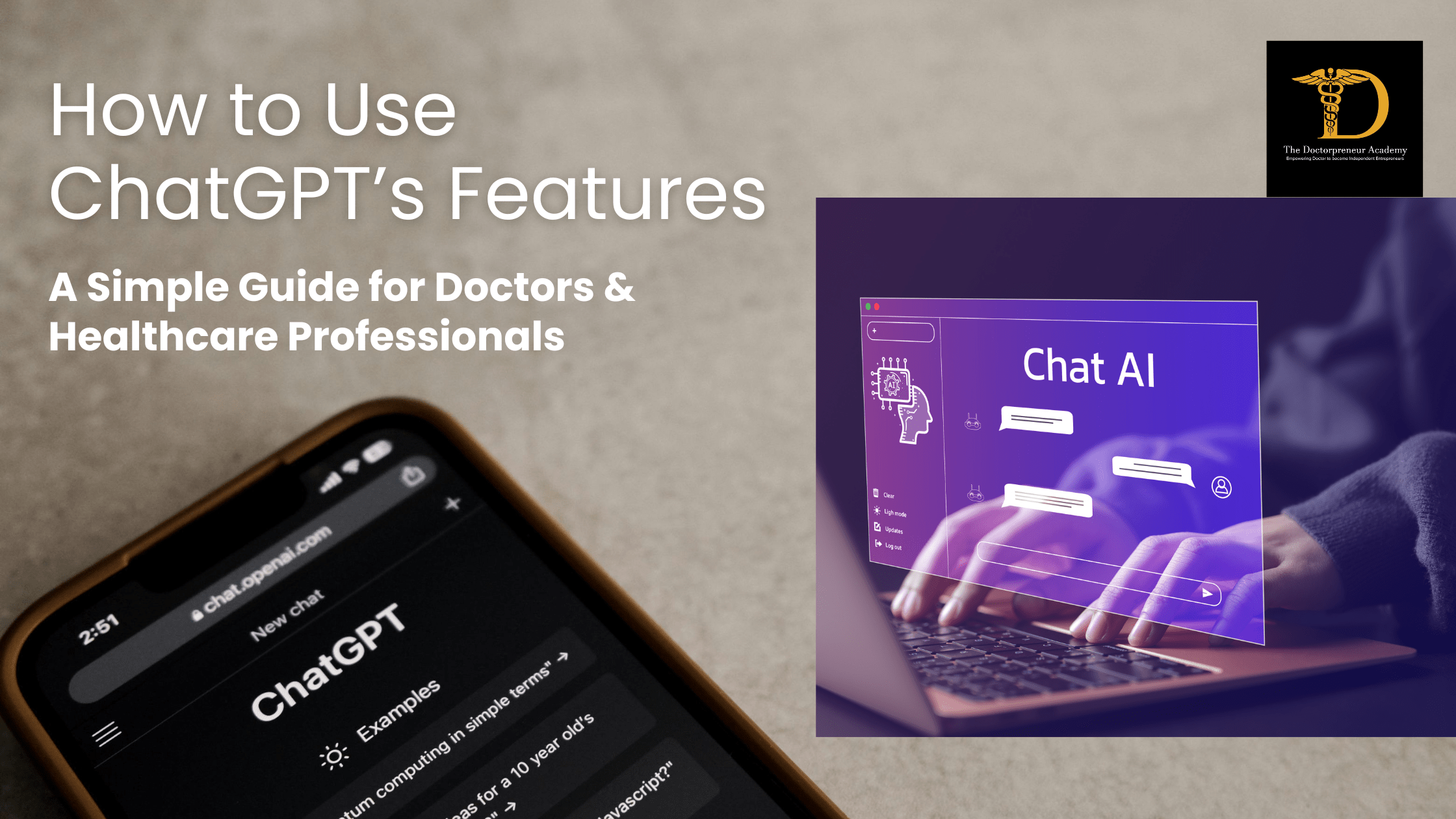Are you a busy doctor who wants to work smarter—not harder? Whether you’re managing patients, running a clinic, creating medical content, or simply staying updated, ChatGPT can make your life easier.
Here’s a clear, doctor-friendly breakdown of ChatGPT’s features, based on the helpful chart from OpenAI. And yes, this includes everything from handling medical reports to summarising research to setting up your schedule.
Let’s explore how ChatGPT can help you as a doctor, practice owner, or health educator.
🔍 1. Search (Web Browsing)
What it does: Looks up real-time info, latest research, citations, weather, news, stock prices, etc.
Use it for:
- Finding the latest medical guidelines
- Checking conference schedules
- Researching recent healthcare policies
🩺 Example for doctors: “What are the updated WHO guidelines on dengue treatment in 2025?”
✅ Need it when: You want quick, accurate, source-backed answers.
📚 2. Deep Research
What it does: Synthesises information into structured reports, perfect for in-depth research.
Use it for:
- Literature reviews
- Creating CME (continuing medical education) content
- Comparing treatment protocols
🩺 Example for doctors: “Write a competitive report on digital health startups in India.”
✅ Need it when: You want in-depth, well-organised insights.
🖼️ 3. Vision (Image Input & Generation)
What it does: Understands and creates images—charts, diagrams, infographics, screenshots.
Use it for:
- Analysing X-rays, reports, or scans (for conceptual understanding)
- Creating patient education infographics
🩺 Example for doctors: “Here’s a floor plan of my clinic. Suggest improvements.”
✅ Need it when: You’re working with or creating visual content.
📷 4. Camera Mode
What it does: Watch your device’s camera feed and guide you in real time.
Use it for:
- Live help with a software tool
- Device setup or digital tasks
🩺 Example for doctors: “Walk me through setting up a telemedicine workflow in Excel.”
✅ Need it when: You want live, step-by-step support.
🗣️ 5. Voice Mode
What it does: Talk to ChatGPT using your voice—hands-free conversation.
Use it for:
- Quick dictation of notes
- Asking questions while driving or walking
🩺 Example for doctors: “Summarise my clinic tasks for tomorrow.”
✅ Need it when: You need hands-free support or voice interaction.
📎 6. File Uploads
What it does: Reads PDFs, PowerPoints, spreadsheets; summarises or analyses them.
Use it for:
- Summarising long medical documents
- Reviewing diagnostic reports
🩺 Example for doctors: “Summarise this 30-page medical study on cervical cancer screening.”
✅ Need it when: You have long files or documents to process quickly.
📊 7. Data Analysis (Code Interpreter)
What it does: Analyses numbers, creates charts, downloads data files.
Use it for:
- Patient analytics
- OPD/IPD trends
- Cost or budget reports
🩺 Example for doctors: “Plot average blood sugar levels in my diabetes patients.”
✅ Need it when: You’re dealing with data or Excel sheets.
📝 8. Canvas (Collaborative Workspace)
What it does: Real-time co-writing space for building documents, projects, apps.
Use it for:
- Creating SOPs, blogs, or presentations
- Collaborating with team members
🩺 Example for doctors: “Help me create a landing page for my online consultation service.”
✅ Need it when: You want to co-create or plan with AI.
🧠 9. Memory (Opt-in)
What it does: Remembers your preferences—like tone, format, or style.
Use it for:
- Personalised replies
- Fast recall of your preferences
🩺 Example for doctors: “Remember that I prefer crisp summaries and British spelling.”
✅ Need it when: You want personalised, faster support.
🛠️ 10. Custom Instructions
What it does: Lets you define how ChatGPT responds to you.
Use it for:
- Setting tone, greeting style
- Repeating specific formats
🩺 Example for doctors: “Always start with a polite greeting and use bullet points.”
✅ Need it when: You want customised conversations.
🗂️ 11. Projects
What it does: Organises your chats, notes, files, tasks into folders.
Use it for:
- Creating medical blogs
- Organising patient education content
- Managing multiple roles (clinician, educator, speaker)
🩺 Example for doctors: “Create a project folder with all my YouTube script drafts.”
✅ Need it when: You want to stay organised across tasks.
🕒 12. Scheduled Tasks (Automations)
What it does: Set reminders, search tasks, or send alerts automatically.
Use it for:
- Daily clinic reminders
- Appointment follow-ups
- Regular updates
🩺 Example for doctors: “Remind me to review lab reports every Monday at 10 AM.”
✅ Need it when: You want to automate repetitive work.
🤖 13. Custom GPTs
What it does: Create or use special bots for niche needs.
Use it for:
- Patient diet planning
- Nursing assistant guides
- Procedure explainer tools
🩺 Example for doctors: “Create a chatbot that guides my patients after knee surgery.”
✅ Need it when: You want a custom AI assistant for your clinic.
🛍️ 14. GPT Store
What it does: Explore and use public GPTs built by others.
Use it for:
- Finding tools made by other doctors
- Using assistants for specific tasks
🩺 Example for doctors: “Find a GPT that helps with creating MCQs for medical coaching.”
✅ Need it when: You want to save time with ready-made tools.
🚀 Final Thoughts from The Doctorpreneur Academy
At The Doctorpreneur Academy, we believe doctors should be empowered with the latest tools. ChatGPT is no longer just a chatbot—it’s your assistant, researcher, planner, and problem-solver.
📣 Call to Action
💡 Want to learn how to use ChatGPT in your practice or build digital systems that save time and grow your impact?
Join us at The Doctorpreneur Academy and start building your digital-first medical journey today!
👉 To register for our next masterclass, please click here https://linktr.ee/docpreneur




